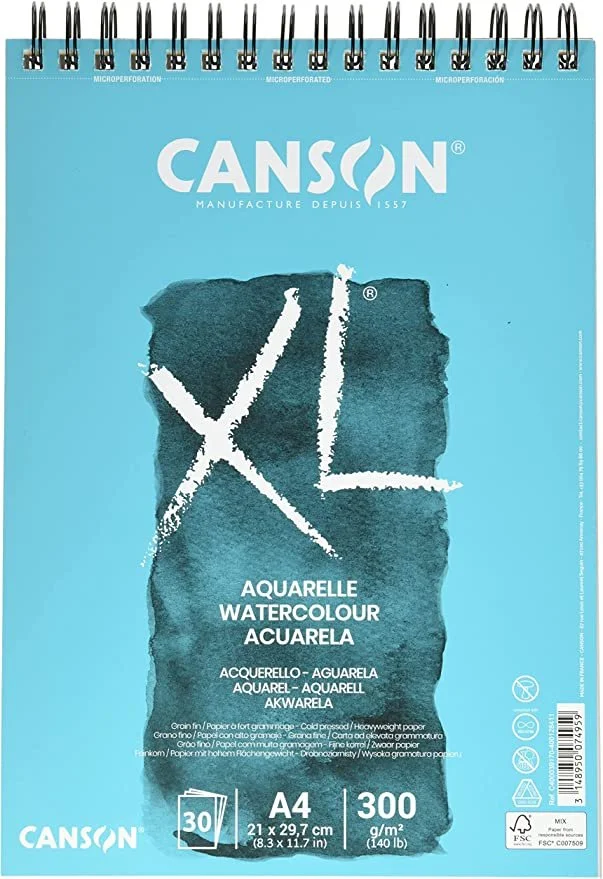Which watercolor paper should I use for practice?
I often see watercolor beginners asking for recommendations on the best watercolor paper to practice on. Even more complaining about cellulose (non-cotton) watercolor papers not giving them the outcome they ‘expected’, and therefore you should only use 100% cotton paper.
I agree to a certain degree. Because not all papers are created equally.
Yes, painting on a good quality watercolor paper can make a difference to your practice outcome and experience.
For example, non-cotton papers can have its limitations such as not being able to hold a lot of water and buckles easily.
On the other hand, one can create gradient more evenly and blend colors more smoothly on cotton paper, as it absorbs water well and pigments can penetrate deep into the paper.
In essence, watercolors will do their magic and produce beautiful effect when used on 100% cotton paper. And you, the artist, feel the joy of painting and build confidence.
But, it doesn’t mean that you’re going to fail your watercolor practice or make your practice less valid if you’re using non-cotton papers.
It all boils down to knowing which type of paper fits your painting style and the techniques involved. Another factor to consider would be your art supply budget.
Before I continue, let me say this: if you are painting to sell or gift as a present, then 100% cotton, acid-free/archival quality papers would likely be your top choice.
Now, let's talk about the factors to deciding which type of watercolor paper to use for your practice.
Budget
Many professional artists recommend practicing with 100% cotton paper to give you the best experience. But we all know 100% cotton paper comes with a higher price tag, and not all of us can afford to purchase them frequently.
For me, when I'm painting as practice or for a home decoration piece, I often use papers that are economical with reasonable quality (e.g. Canson XL Aquarelle 300 gsm cold-pressed paper, student-grade paper made from cellulose). I wouldn't want to 'waste' Arches cold-pressed papers on practice pieces.
That said, if you can find 100% cotton paper that is less expensive or fits your budget, then go for it.
When I want to use cotton paper for practicing, my paper would be from Arto by Campap (I think it’s a Malaysian brand - I’m not sure - but the paper origin is Netherlands). It's cheaper than Canson XL, but the quality is not bad at all.
Techniques and style
If you’re painting, say, landscapes or loose watercolor florals that require a lot of water (wet-on-wet technique) and layering, then choose 100% cotton paper, with at least 300 gsm paper weight. You can go for the normal cold-pressed or the rough surface paper (if you like the paper textures to show through).
If your painting style doesn’t involve a lot of water or layering (e.g. simple illustrations with mostly wet-on-dry technique), then practicing on cellulose or cellulose-cotton mixed papers shouldn't cause much of an issue.
If your work has a lot of details, such as in botanical illustrations, a paper with a less textured surface is easier for painting the details. You can go for hot-pressed paper (its surface is smoother than cold pressed paper). There are cotton and non-cotton versions as well. So choose the one that fits your end purpose and budget.
For me, I like to practice botanical painting on Canson XL watercolor paper, because I don’t apply wet-on-wet a lot and the paper surface is less toothy than cotton cold-pressed papers. My Arches hot-pressed 100% cotton paper (one of my favorites now) are reserved for important watercolor collection pieces.
***********
So, this is just a general overview of how I’d choose my watercolor paper for practicing. I hope it helps you a bit when it comes to choosing your watercolor paper.
It's important to choose the paper based on your painting objective, method and style, and not what others said. But don’t be afraid to try out different types and brands of paper to find one or two that suits you the best.
You can look for sample packs that include a mix of papers: cold- and hot-pressed, cotton and non-cotton, different paper weights and various brands. Try them out and keep in mind a selection of papers that would fit your needs.
Buy the best that you can afford within your budget. Use what you have and make it work for you. And save up for the better papers in your wish list.
So, which watercolor papers are you using now? Any favorites? Let me know in the comment box.
*This post contains affiliate links. Meaning, if you make a purchase through these links, I may receive a small commission at no extra cost to you.



